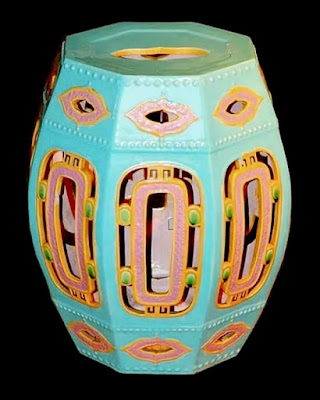About six months ago. I received an email from a writer at Main Line Today magazine.
He was writing an article on Etruscan Majolica and asked if I could send him copies of my two books on Etruscan Majolica for review purposes. I debated the idea for a couple of weeks before being persuaded by people I trust to send them to him.
Working in the magazine industry myself I know that it isn't always easy to get accurate reference material when working against a deadline so I felt pretty good about my decision to contribute to the article.
Well, I finally got a look at the finished article today. It is in the February issue of Main Line Today magazine.
It's a nice, overview account of the history of Etruscan Majolica.
I would very much like to thank author J.F. Pierro for including a mention of my Etruscan Majolica Web site in the article. He was also nice enough to quote my book near the end of the article. I can tell that he clearly read my book by the structure of the article. Yet, his article still has some of the same misinformation that has circulated about the Etruscan Works for years. It is these old wives' tales that I wrote the book to dispel, but they have surfaced once again.
I can't say I totally blame Mr. Pierro. He obviously interviewed a number of people instead of just relying on my book and an author's story is only as good as his sources. Some of these stories are harder to kill than a vampire in a blood bank. Still, he did have my book which is accurate and specifically addresses these issues.
Old Wives' tale # 1: William Hill was not involved in the production of Etruscan Majolica.
This one is easy to dispel. There are newspaper articles that date the production of Phoenixville majolica to April of 1879. Hill was actively involved in the Phoenixville pottery from January 1879 to May 1880. That would mean that majolica was in production during his tenure there.
Old Wives' tale # 2: The 1890 fire ended the production of Etruscan Majolica.
The plant fire in December of 1890 had nothing to do with the end of Etruscan Majolica.By 1890 the Etruscan brand had been out of production for almost two years. After David Smith left the Phoenixville Pottery in 1889, the Etruscan name was retired and the pottery took on the mark of Griffen, Love and Co. and later the Griffen China Company. Monochromatic majolica production did continue on a limited scale until around 1895 under the name of the Chester Pottery, but never again under the Etruscan banner.
Old Wives' tale # 3: President Grant bought Etruscan Majolica for his daughter.
This is a total fabrication. President Grant's daughter did own pottery made at the Phoenixville Pottery but it was a solid cobalt display set with over painted decoration given to her by W.H. Schribner as a wedding gift in 1874 from the people of Pennsylvania. This was five years before production of majolica began at the plant.I am always happy to see Etruscan Majolica receive such a nice write up from a local publication, but I would hope that the article would be totally accurate.
If you would like to read the article for yourself go to the Main Line Today Web site.













































































